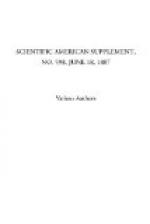The Month Item.—If it begins or ends with a vowel, subtract the number denoting its place in the year from 10. This, plus its number of days, gives the item for the following month. The item for January is “0;” for February or March (the 3d month), “3;” for December (the 12th month), “12.”
The Day Item is the day of the month.
The total thus reached must be corrected by deducting “1” (first adding 7, if the total be “0"), if the date be January or February in a leap year; remembering that every year divisible by 4 is a leap year, excepting only the century years, in new style, when the number of centuries is not so divisible (e.g., 1800).
The final result gives the day of the week, “0” meaning Sunday, “1” Monday, and so on.
EXAMPLES.
1783, September 18.
17 divided by 4 leaves “1” over; 1 from 3 gives “2;” twice 2 is “4.”
83 is 6 dozen and 11, giving 17; plus 2 gives 19, i.e. (dividing by 7), “5.” Total 9, i.e., “2.”
The item for August is “8 from 10,” i.e., “2;” so, for September, it is “2 plus 3,” i.e., “5.” Total 7, i.e., “0,” which goes out.
18 gives “4.” Answer, “Thursday.”
1676, February 23.
16 from 18 gives “2.”
76 is 6 dozen and 4, giving 10; plus 1 gives 11, i.e., “4.” Total “6.”
The item for February is “3.” Total 9, i.e., “2.”
23 gives “2.” Total “4.”
Correction for leap year gives “3.” Answer, “Wednesday.”
LEWIS CARROLL.
* * * * *
PRECIOUS STONES OF THE UNITED STATES.
To the recently distributed government report on the mineral resources of the United States for 1885.[1] Mr. G.F. Kunz contributes an interesting chapter in which is recorded the progress made during that year in the discovery and utilization of precious stones.
[Footnote 1: Mineral Resources of the United States: Calendar Year 1885. Washington: Government Printing Office. 1888.]
In the summer of 1885, a remarkably large pocket containing fine crystals of muscovite, with brilliant crystals of rutile implanted on them, was found at the Emerald and Hiddenite Mining Company’s works, at Stony Point, N.C., and was sold in the form of cabinet specimens for $750. While the soil overlying the rock was being worked, nine crystals of emerald were found, all of which were doubly terminated, and measured from 1 inch to 3-1/8 inches in length and 1-2/3 inch in width. One of these crystals is very perfect as a specimen, being of a fine light green color, and weighing 83/4 ounces. It is held by the company at $1,500, and the nine crystals together at $3,000. Another of these crystals, doubly terminated, measures 21/2 inches by 11/12 of an inch, and is filled with large rhombohedral cavities, which formerly contained dolomite. The only crystal from this collection that has been cut into a gem was found in a pocket at a depth of over 43 feet. In color it is of a pleasing light green, and it weighs 4-22/32 carats. No crystal of a finer color has as yet been found in the United States, and the gem is held by the company at $200.




